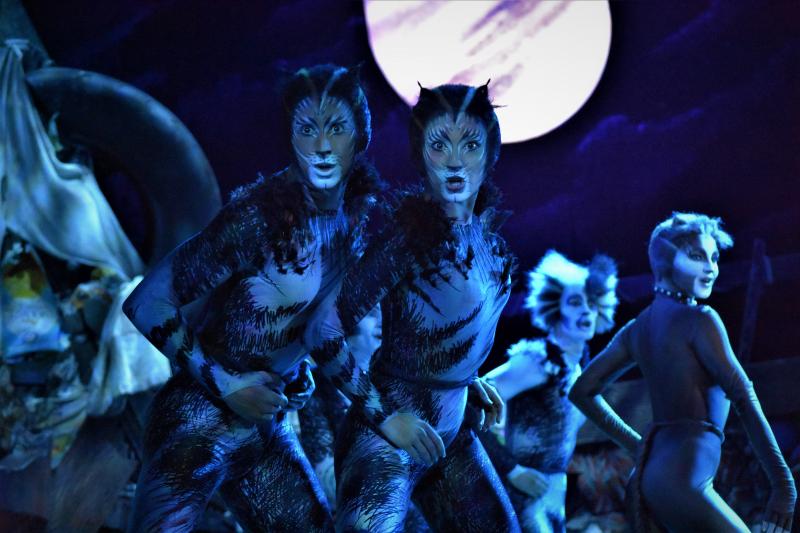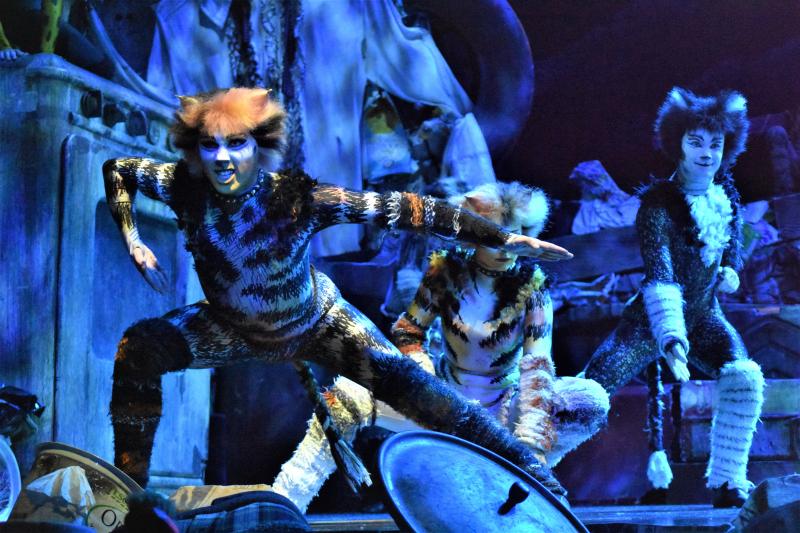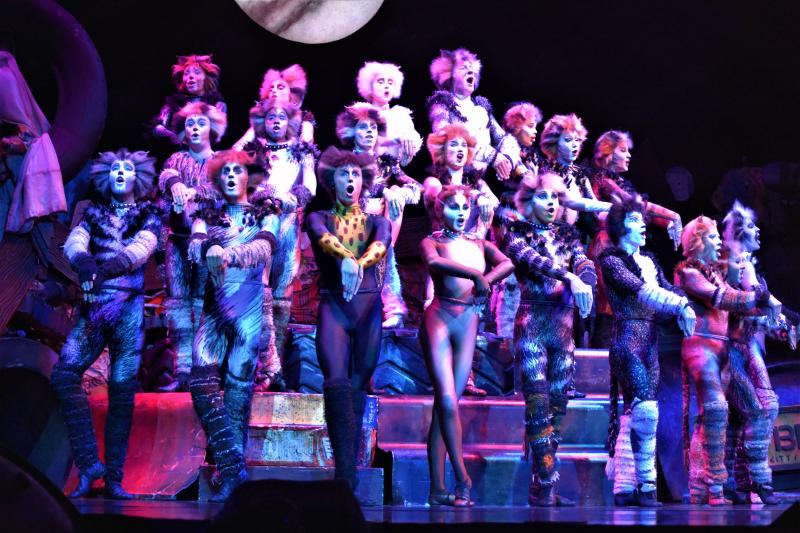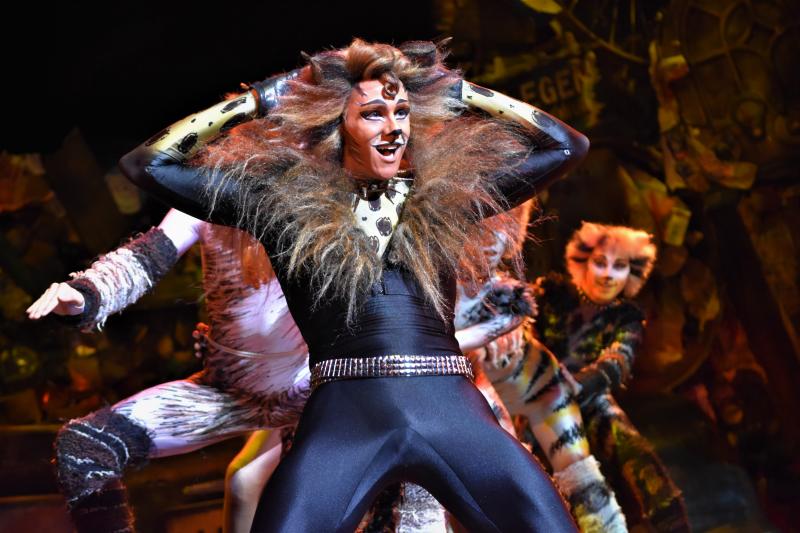Review: CATS, A Litter Ground of Spectacle, Mystery, Fun and Nostalgia
![]()

Cats is not your ordinary musical. In fact, it's a sung-through piece of dance theater, which was conceived for the West End stage at a time when Andrew Lloyd Webber had never yet had a huge hit, and the emerging art form was heavily identified with the American Theatre.
Manila, Philippines - The Andrew Lloyd Webber-Cameron Mackintosh megamusical Cats returns to Manila in a UK touring production that features international Filipino actor Joanna Ampil as Grizabella. Not long ago, Tony and Olivier winner Lea Salonga, another Filipino pride, essayed the iconic role.
With a global radio hit "Memory" neatly tucked under its belt, Cats is sure to ignite nostalgia among its local fans who have made Cats this side of the world a musical phenomenon up to this day since its debut on a London stage on May 11, 1981.
Historically, Cats had a rough beginning, to say the very least - from detractors incredulous at the thought of a British dance musical at a time when it was believed that only Americans could do a dance show, to that eventful opening night when a bomb scare literally sent fully costumed actors and the audience fleeing to a London street right after the curtain call.
On November 7, 2019 gala opening, thankfully, Cats opened at The Theatre at Solaire to a house packed with excited and eager old and new fans without any hitch, and the standing ovation that punctuated the two-hour spectacle clearly indicates that this 38-year-old musical can still purr and leap its way into people's hearts.
Like most of the Broadway megamusicals I saw (and reviewed) in Manila for the first time, I entered the theatre with very high expectations and a nagging apprehension of a thought: will this one live up to all the hype? When much has been said about a musical that's iconic in stature (Cats started the megamusical trend), the very act of judging it - from your perspective and experience - for publication is almost unnecessary and not without a shadow of fear.

Taming the Cats in Us
Upon entering the theatre, the dimly lit stage - a cacophony of human refuse strewn all over the performance space in choreographed disarray - beckoned like some dangerous affair. The theatre filled up in no time, and to my right, a mother and her young daughter took their seats almost stealthily. The little child, no older than a third-grader, sat quietly, eyes darting from left to right of the stage, somewhat wary. I smelled in her something familiar - my own fear. I momentarily laughed at my silliness. She was just a kid, I scolded myself. When the overture started blaring in and the lights in the theater dimmed, I postured myself excitedly. The little girl stiffened up when, from the rear of the auditorium, glowing feline eyes started to manifest in the dark. On stage, a solitary cat, amidst a junkyard brimming with blinking lights, warily ran across. Here we go.
Cats is not your ordinary musical. In fact, it's a sung-through piece of dance theater, which was conceived for the West End stage at a time when Andrew Lloyd Webber had never yet had a huge hit, and the emerging art form was heavily identified with the American Theatre. Unlike the Disney monster hit "The Lion King" that uses a "double event" puppetry, an innovation that allows you to see both the actor and the puppet as one anthropomorphized unit, Cats completely disguises the human actor in furry costumes and thick makeup. Most of what Cats wants to convey is expressed in jazz dances that simulate feline movements that are both human and cat-like. The overall effect can be intriguing and scary - what with huge cats in front of you pretending to be small cats. But there is something "mysterious" in this Tony Award-winning masterpiece that needs to be "tamed."
When the tingly "Jellicle Songs for Jellicle Cats" summons in the cats in various furs and characters, and cats' names are demystified in the playful number "The Naming of Cats," the fear-mystery vibe turns into excitement - an invitation to a ball.

The Jellicle Ball
My eyes already accustomed to the dark auditorium, I saw the little girl jumping onto her mother's lap. By this time, some cats had climbed down the stage and slinked into the audience area in what seemed to be an act of "taming" the audience. A male gray and white cat drew close to the little girl, with a look that exuded a put-on friendly curiosity. This act sent the child cringing into a tiny human ball. On her headful of hair, I caught sight of a metal headband with pointy ears sticking out. She's got cat ears.
Based on T.S. Eliot's "Old Possum's Book of Practical Cats," a collection of bedtime poems, which the poet intended for his godchildren, Cats, at the outset, seems to have no clear storyline. The spoken lines delivered mostly in their original form (Webber claims minor revision in the tense or pronoun), one has to listen and watch intently to uncover the sly plot. What seems to be a showcase of playful cats and their obligatory three names gets a twist with the entrance of Grizabella, the Glamour Cat, her arrival preluded by that unmistakable hint of melody that established Cats with a major radio hit - its signature song.
The story progresses with the arrival of Old Deuteronomy, a warm and loving old cat, who is respected by all the cats in the tiny junkyard. The storyline establishes itself with the much-awaited number, "The Jellicle Ball," where the musical's plot is revealed: at the end of the ball, one lucky cat will be chosen to journey to the Heaviside Layer, where he or she will get a chance at rebirth. The suspense builds to a nostalgic high with Grizabella singing a portion of "Memory" that establishes her character, a central figure to the musical's plot.
Moments of Happiness and Nostalgia
At the announcement of the interval, the lights revealed the little girl back in her seat. The occasional interaction of cats with audience members somehow loosened the girl's stiffness. In those moments, between my professional obligation to my editor and curiosity for the girl, I saw her connecting pointing fingers with that gray cat. Although rather nervously, hers was a welcome sight, and I heaved a sigh of relief, not for myself, but for the young impressionable mind a seat away. The interval went by so fast, I noticed. Darn, my excitement was now shamelessly palpable.

Act 2 begins with an antithetically somber number "The Moments of Happiness." With this number, nostalgia sets in on a heavy dose as Jemima (Holly Willock) echoes Grizabella's longings. This nostalgia is sweetened by the introduction of lovably delightful Asparagus (Andrew Keelan), the Theatre Cat. At this point, the scary and dark vibe of the musical has tilted to the sunny side, and I could hear snickering from all sides of the auditorium. Perhaps one of the surprises that the production pulled off was a female cat singing a heavily accented Tagalog translation of a portion of "Memory." Although it took some while to sink in, the audience roared in approval at the warm attempt.
Webber's music establishes itself as a veritable element by Act 2. The genius of Webber's music lies in its dynamics and versatility. Together with Eliot's poetry, the score is a treasure trove of dynamic, fun, playful, dramatic, and nostalgic numbers - its appeal in each number's ability to persuade the listener despite the unfamiliar rhymes. No longer are the poems bedtime staples for kids: they have become mirrors of human lives personified in these make-believe nonchalant but vulnerable creatures.
With the major characters now sashaying the storyline and plot, identifying ourselves with the cats has become easy. There's Jennyanydots (Amy Whittle), the Old Gumbie Cat who lounges all day, the standout white cat Victoria (Ellie Young) who's a primary part of the storytelling process, the prankster Rum Tum Tugger (George Hinson) who enjoys the adoration of the girls, the formidable duo of Mungojerrie (Joe Henry) and Rumpleteazer (Kirsty Ingram) who always find themselves in trouble, the has-been actor Gus (Asparagus) who longs to perform in the theatre again, the perfectionist and ever nice Skimbleshanks (Gavin Eden), the evil and perennial trouble maker Macavity (Thomas Inge), the flamboyant conjuring cat Mr. Mistoffelees (Harry Francis), the wise Old Deuteronomy (Nicholas Pound) who leads the clowder, and Grizabella, the formerly glamorous cat who is now disdained by the rest.
Mystery Uncovered
Torn between the cats and the little girl, the occasional glimpses I threw in the child's direction became now numerous and almost a reflex. Deep into the second act, she was now exchanging high-fives with most of the cats that came to our aisle, and with cats making sure she appeared to be the yarn ball of their eyes, she now seemed to enjoy the attention. I could hear her snickering with the rest of the audience, and more than once I was tempted to give her an assuring tussling of her hair. The mother, who was nice and genial, seemingly approved of my tiny gesture. The kid had finally come around.

Halfway through the second act, the mysterious appeal of Cats has been fully unraveled. It lies in that spectacle courtesy of a perfect marriage between music and choreography, and a suspenseful storyline that makes you glued in your seat, waiting for something wonderful to discover, number after number, spectacle after spectacle.
Gillian Lynne's original choreography and Trevor Nunn's direction showcase triple-threat actors who possess spectacular gifts in acting, singing, and dancing. Leading the cast is Andrew Keelan as Asparagus who warmed and tickled our hearts as the has-been theater actor, Thomas Inge who caused quite a stir and pandemonium as the evil prankster Macavity, George Hinson who tickles and delights as Rum Tum Tugger, and Harry Francis as Mistoffelees who thrills and whirls in his sensational barrel turns and high jumps. And then there's Joanna Ampil whose Grizabella will break your heart and rouse you to thunderous applause with her rendition of "Memory" towards the end of Act 2 - the jewel and crown of your patient wait.
Long after I exited the theatre, the memory of a literary gem, whose excerpt still haunts me to this day, came like a welcome ghost. It was the denouement of Clarice Lispector's Brasilia, which somehow made my "fear" of "cats" a serendipitous journey. And I have that little girl to thank.
"There is something here that frightens me. When I figure out what it is that frightens me, I shall also know what I love here. Fear has always guided me toward what I desire. And because I desire, I fear. Often it was fear that took me by the hand and led me. Fear leads me to danger. And everything I love is risky."
The Verdict
Cats is not an easy piece of theater but your patience will be richly rewarded. Altogether, it's a litter ground of spectacle, mystery, fun, and nostalgia - a trophy befitting the virtuous who patiently wait.
Check out photos taken at Cats.
Read our interview with Joanna Ampil.
Photos: Oliver Oliveros
Reader Reviews

Videos


